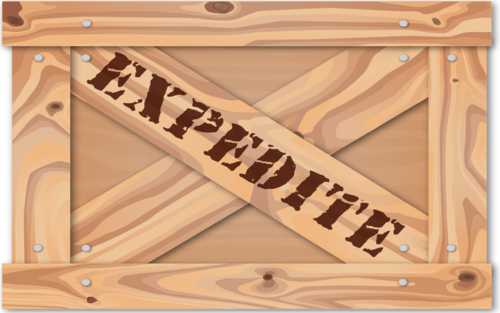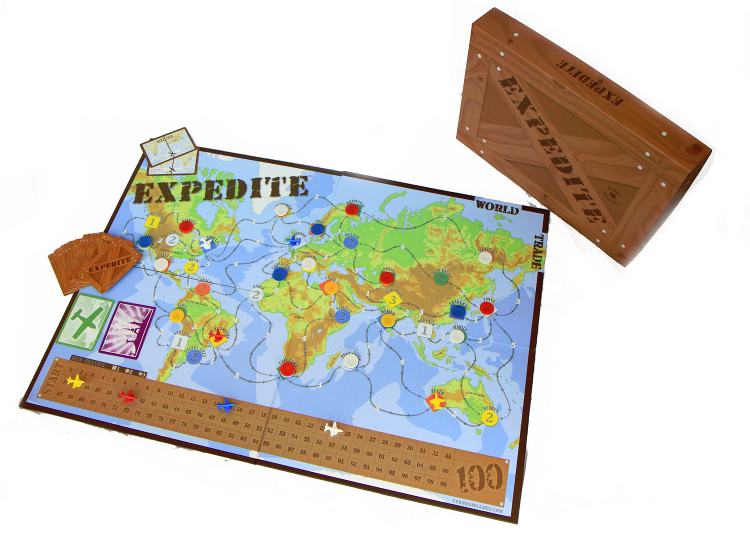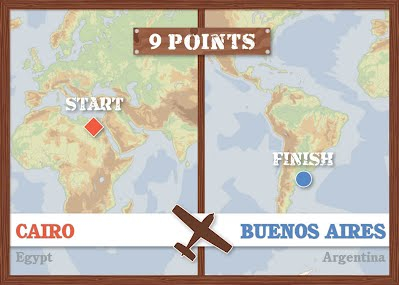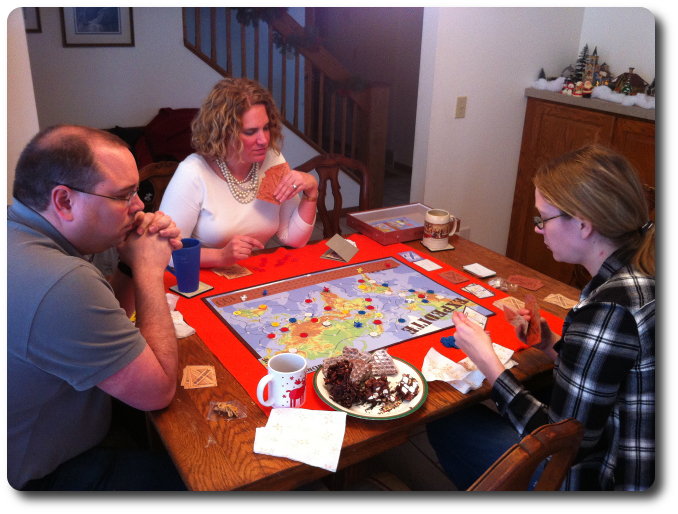
The Basics:
- For ages 10 and up
- For 2 to 4 players
- Variable game length
Geek Skills:
- Counting & Math
- Logical & Critical Decision Making
- Reading
- Emotional Coping Skills
- Pattern/Color Matching
- Strategy & Tactics
- Hand/Resource Management
- Area Control
Learning Curve:
- Child – Easy
- Adult – Easy
Theme & Narrative:
- Become a leader in the airline travel and delivery industry by purchasing airport hubs around the world.
Endorsements:
- Gamer Geek rejected!
- Parent Geek approved!
- Child Geek rejected!
Overview
They say the sky is the limit, but this is not technically correct. The sky, in this case, is just the beginning and the means to achieve your goals of global influence as a world airline power. Before you is the map of the world and each country represents a destination and opportunity. If you connect the people, the money will follow. But you have fierce competition and what you own now can be taken from you. Nothing is certain. Time to fly the not-so-friendly skies!
Expedite, by Turnham Games, is comprised of 1 large game board (that depicts the flight paths and major airport hubs around the world), 100 colored player chips (in colors blue, red, yellow, and white; 25 of each), 54 World Trade cards (that show starting and ending destinations), 90 Plane cards (in colors blue, red, white, green, and yellow; 18 of each), 10 Wild cards (that can represent any colored Plane card), 3 Free Hub cards, and 8 Airplane pawns (in colors blue, red, yellow, and white, 2 of each).

Game Set Up
To set up the game, first place the game board in the middle of the playing area and within easy reach of all the players.
Second, have each player select a set of Airplane pawns of the same color and the matching colored player chips. Each player now places one of their Airplane pawns on the “Start” space located on the score track at the bottom of the game board.
Third, combine the Plane, Wild, and Free Hub cards into a single deck and shuffle. Then deal out to each player a single card, face-up. Continue to deal cards face-up until a blue colored Plane card is revealed. This player is the “First Player” for the duration of the game. Collect and reshuffle all the dealt cards into the deck. Place the deck aside for a moment.
Fourth, shuffle the World Trade cards and deal 3 to each player, face-down. Players can look at these cards but should keep them hidden from their opponents at all times.
Fifth, the First Player places their Airplane pawn on any hub space on the game board. Followed by the next player going clockwise. This continues until all the players have placed their Airplane pawn on the game board. A hub cannot be owned by more than 1 player. The hub that the player claims is owned by them for the duration of the game and cannot be moved, removed, stolen, or purchased by their opponents.
Sixth, all the players should now review their World Trade cards. If any World Trade card lists a starting hub owned by an opponent, they can now replace it with a new World Trade card.
Seventh, deal 4 Plane cards to each player, face-down. Players can look at these cards but should keep them hidden from their opponents at all times. Place the remaining deck to one side of the board and draw the top 2 cards, placing them face-up next to the draw deck.
You are now ready to play! Start your engines and take off! First player, obviously, goes first.
The Wild Blue Yonder
The game is played in turns. On a player’s turn, they have four options available to them. A player can only select one of the four. Once they have completed their turn, the next player goes in turn order. This continues until the game’s victory condition is met. The options follow.
Option 1: Draw Plane Cards
This option allows the player to either draw 3 Plane cards from the Plane deck or take the 2 visible Plane cards next to the deck. Not both. A player can never take cards from the discard pile. The cards are added to the player’s hand (there is no hand size limit) and can be used on the player’s next turn. If the 2 visible Plane cards are taken, draw 2 cards from the Plane deck to replace them. If the Plane deck is ever exhausted, reshuffle the discard pile to create a new Plane deck.
Option 2: Purchase a Hub
This option allows a player to purchase a hub location on the game board. Hubs cost either 1, 2, or 3 Plane cards of a specific color when the game first begins. The number of Plane cards required is noted by the number on the hub. The color required is represented by the color of the hub. Once purchased, the player places one of their player chips on the hub location and the used Plane cards are placed in the discard pile, face-up.
Players can purchase hubs already owned by other players, but can never purchase another player’s home hub (the hub with the Airplane pawn). To purchase a hub already owned by an opponent, the color required remains the same, but the number of Plane cards required is now the initial cost of the hub plus the cost of the hub multiplied by the number of player chips located on it (including the one to be placed by the player). For example, if the hub cost 3 red Plane cards, and the hub had 1 player chip on it, the hub would now cost 9 red Plane cards.
3 for the initial cost + 3 for the first chip + 3 for the second chip = new hub cost
One purchased, the player places their player chip on the top of the stack of any previously placed player chips, signifying they now own the hub. There is no limit to the number of player chips in a stack.
Wild cards can be used to represent any color the player likes. The Free Hub card can be played alone to purchase any hub except a player’s home hub. The Free Hub card is a very powerful card, indeed.
Option 3: Play a World Trade Card
This option allows a player to reveal one of their World Trade cards to advance their Airplane pawn on the score track.
To claim a World Trade card, the player must own the starting location (with their Airplane pawn or a player chip) and every hub on the route must be owned by a player. None of the hubs on the route, other than the starting location, need to be owned by the player who is playing the World Trade card, but it is in their best interest to own as many as possible.

The number of points each World Trade card is worth is listed on the card. Between each hub is a route line. Listed on these route lines is a number value. If a player is traveling from one hub to another, and the hub they are traveling to is not owned by them, the number on the route line is subtracted from the total points awarded by the World Trade card and given to the player who owns the hub the route line connects to. In this way, a player who completes a World Trade card could advance not only their own Airplane pawn on the score track but one or more of their opponents’, too.
Once the World Trade card is played, the points determined, and the Airplane pawn positions adjusted on the score track, the World Trade card is discarded and the player draws a new one.
Option 4: Discard a World Trade Card
This option allows the player to discard one of their World Trade cards and draw a new one.
Winning the Game
The game ends as soon as a player’s Airplane pawn crosses into the 100 points section on the score track. A player need not make 100 points exactly, nor does it need to be the player’s turn. For example, if the player’s Airplane pawn advances to the 100 point section because another player had to share their World Trade points with them, they win.
To learn more about Expedite, visit the game’s web page.
Prediction
This is not going to be a difficult game to teach any of our groups. They are already familiar with another game that has very similar game mechanisms and game play. If you haven’t guessed by now, I am talking about Ticket to Ride. Expedite is not a complicated game (very simple rules of play) and with the players already having a good deal of experience with Ticket to Ride (which shares similar game play), teaching this game is going to take very little time or energy. That’s a nice change for me.
But will the players enjoy the game? I think the Parent Geeks will as they have already shown they enjoy games like Expedite. The Gamer Geeks will find Expedite “passable”, at best, as the game is not really doing anything unique, although the way hubs change hands and the sharing of points should motivate them to give the game a pretty close look. For the Child Geeks, I have some reservations.
The game play, again, is simple. I have no doubt that our Child Geeks will be able to understand it and play it well. What has me concerned is how quickly and easily a hub can change hands. Child Geeks look at their games as “tasks” that they must complete. If they work particularly hard to get a specific hub only to have it taken from them by the next player, you can imagine their level of disappointment. Heck, even adults are going to be less than pleased if the same scenario happened to them. Expedite will either fail or succeed based on how much or little the Child Geeks feel like they are being jerked around.
And so, I put the game in front of my little geeks (my 5 and 8-year-old), told them it was like Ticket to Ride, showed how the points were scored, and we were off. My 5-year-old was going to need help with the counting, but he could do everything else himself. I told them it was perfectly OK to ask other players to turn away from the table so they could “finger walk” from their starting location to their end location. This was the only way I could make the game fair and to avoid players purchasing hubs they knew their opponent’s wanted. When both of my little geeks were ready to go, I asked them their thoughts on the game so far.
“This is planes instead of trains. I can play this game, easily.” ~ Liam (age 8)
“I’m going to call my company Firecat Jets!” ~ Nyhus (age 5)
Time to take off and see if this game can fly high or crashes into a mountain of disaster.
Final Word
Expedite was doing very well with the Child Geeks until their hubs started to get purchased out from underneath them. They would buy them back, only to have them stolen again. The word “stolen” is technically not correct, but that’s how the Child Geeks felt. There is a high level of player interaction and competition when it comes to hubs and it feels downright aggressive at times. Too aggressive, in fact, and the Child Geeks we played the game with didn’t like it one bit. That’s why we listed “emotional coping skills” in the summary section of this review. Players have to be OK with their routes being yanked out from underneath them with no way to avoid or stop it. The game bombed with our Child Geeks.

One of our earlier plays with two Parent Geeks and a Gamer Geek
The Parent Geeks didn’t care for other players taking their hubs, either, but they loved taking hubs from their opponents. One Parent Geek who was very familiar with Ticket to Ride said they liked Expedite better because there was more control given to the players. Very true. It is terribly frustrating to have your game plans destroyed with no chance of gaining it back. In Expedite, a player always has an opportunity to connect routes and buy hubs, but not necessarily the means. On the other side of the fence were the players who didn’t care for the aggressive nature the game required and said they found the game to be strangely combative in a very casual way. The Parent Geeks ultimately decided to approve the game, but hated the Free Hub card with a passion.
The Gamer Geeks thought the game was “OK” at best. They liked some of the game mechanisms and found that a player did have a lot more control over their game, but not significantly enough to gain momentum. This was the ultimate reason why the Gamer Geeks decided to not endorse Expedite. Some felt the game was “broken” and could be won by simply owning the major hubs and collecting points from the other players. Others thought the game play was flawed because players wouldn’t want to play a World Trade card if it meant giving an opponent points, thus making the game length longer in the processes. It should also be noted that none of the Gamer Geeks thought the 2 visible Plane cards were of any use unless there was a wild or Free Hub card visible. Oh, and they hated the Free Hub card, too. “It breaks the game”, said one Gamer Geek (despite the fact he played them all the time). In the end, the Gamer Geeks didn’t think the game was original enough to be of interest. What originality it did have didn’t win them over and the game play left them feeling like Expedite wasn’t finished being designed.
I think Expedite is a bit quirky in some spots, but I’d play it over the train game any day. There is more player interaction and the game feels deeper. I’m able to adjust my game as I go, take calculated risks, and build up a power base too expensive to topple. I like that and the fact that the game allows me to work on claiming routes for points even though they might be owned by other players. I can go after what I want when I want it. Of course, the downside is the other players can, too. The end result is a game that is surprisingly aggressive at times and very slow during others. There were long stretches in the game where players were just collecting cards, not willing to claim routes because it would mean giving points to their opponents.
The noted completion time for Expedite is 30 to 45 minutes. I think a better time estimate would be “variable”. While players who are very familiar and aggressive with the game could complete a single play session in as little as 30 minutes, one of our groups took 2 hours. There is nothing in the game that forces a player to play cards, no player hand size limit, every hub (except the home hubs) can be purchased multiple times, and the game doesn’t end until a player makes 100 or more points. This means the game could go on as long as the players like, which is actually very freeing. Expedite gives players all the time they need to play and win the game without placing some arbitrary time limit to push the players forward. First to the finish line wins and that’s it. Just be aware that you can help your opponents win the race before you.
Let’s address a few other sticking points that are circulating around the geek-o-sphere about this game.
- Yes, this game is very similar to Ticket to Ride. If you’ve played Ticket to Ride, you’ll understand how to play Expedite in less time than it took you to read this bulleted sentence.
- No, it’s not a copy or a ripoff of Ticket to Ride. It has similar game mechanisms, but the game play is different.
- Yes, the super powerful Free Hub card is too powerful. It allows players to take a hub, regardless of its price, for free.
- No, you don’t have to play with the Free Hub cards. There are only 3 in the game and you can remove them from play without upsetting the game play.
- Yes, this game can be seen as a “gateway game” because it’s easy to teach and easy to learn.
- No, it’s not a good “gateway game” because it’s a bit too heavy, too aggressive, and too chaotic at times to be a good “first step” into the gaming world.
- Yes, this game feels very unbalance at times. This is especially true when you are the last player to select your home hub.
- No, the game is not unbalanced. It’s just very hard to make up for lost point if you don’t want to share any with other players.
- Yes, this is a game about flying airplanes around the world.
- No, you cannot fly directly from Russia to Alaska, or vice versa.
So where does this put Expedite? Too much for the Child Geeks, not enough for the Gamer Geeks, and most of the time “just right” for the Parent Geeks. This is a hard game to place, but I don’t think it is much of a stretch to suggest the game would be well received by casual players looking for a game that is just slightly more aggressive and interactive. The game has merit and I like many of its design and rule choices. It’s not a perfect game by any means, but I’m enjoying it. I suggest you give it a try. If you like it, great! If not, there are always trains to play with.
This game was given to Father Geek as a review copy. Father Geek was not paid, bribed, wined, dined, or threatened in vain hopes of influencing this review. Such is the statuesque and legendary integrity of Father Geek.



